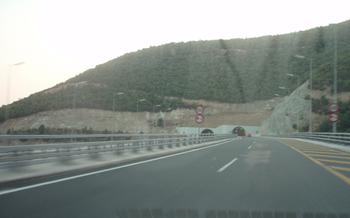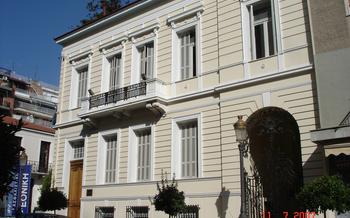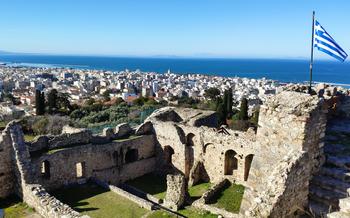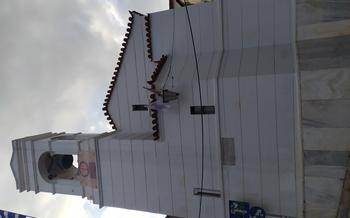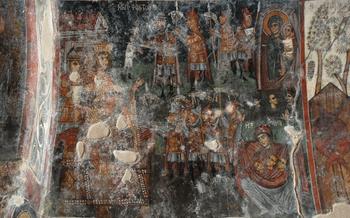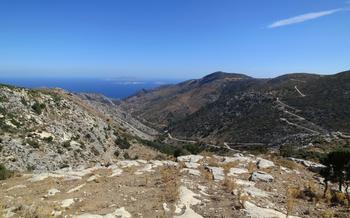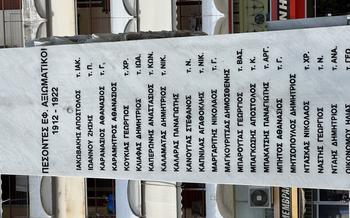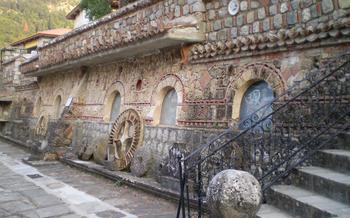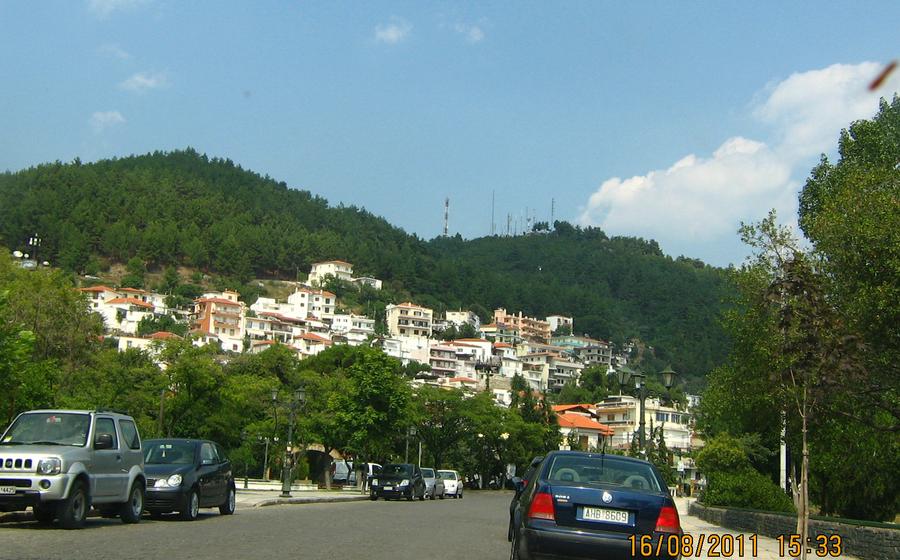
The Holy Monastery of Panagia Archageliotissa
- Xanthi's Religious Jewel: The Holy Monastery of Panagia Archageliotissa
- A Journey Through Time: The Monastery's History
- Architectural Masterpiece: Exploring the Monastery's Design
- Cultural Heritage: The Monastery's Contribution to Greek Orthodoxy
- Unveiling the Monastery's Treasures: Icons and Artifacts
- The Church of Panagia Archageliotissa: A Sacred Space
- Monastic Life: A Journey of Faith and Devotion
- Exploring the Surroundings: Nature's Embrace
- Events and Festivals: Celebrating Faith and Tradition
- Pilgrimage Experience: A Journey of Faith
- Volunteer Opportunities: Serving the Community
- Practical Information: Planning Your Visit
- Insider Tip: Unveiling Hidden Gems
Xanthi's Religious Jewel: The Holy Monastery of Panagia Archageliotissa
In the heart of Xanthi, stands the Holy Monastery of Panagia Archageliotissa, an architectural masterpiece that has stood the test of time. Its journey began in the 12th century, when it was founded by a group of devout monks seeking a secluded place to devote their lives to prayer and contemplation. Over the centuries, it has become a beacon of spirituality, attracting pilgrims and visitors from near and far.
The monastery's architecture is a testament to the rich history and cultural influences that have shaped Xanthi. Byzantine and Ottoman elements blend harmoniously, creating a unique and awe-inspiring sight. The monastery's walls, towers, and gates exude an air of strength and resilience, while its interior spaces offer a glimpse into the tranquil world of monastic life.
As a significant pilgrimage site for Orthodox Christians, the monastery holds a deep spiritual significance. Pilgrims flock to the monastery to pay homage to the miraculous icon of Panagia Archageliotissa, believed to possess divine powers. The monastery's numerous churches and chapels provide a serene setting for prayer and contemplation, making it a sanctuary for those seeking spiritual enlightenment.
Beyond its religious importance, the monastery also plays a vital role in preserving and promoting Greek Orthodox traditions and culture. Through its educational programs, workshops, and cultural events, the monastery serves as a center for the transmission of Orthodox values, customs, and arts. Its contribution to the cultural heritage of Xanthi is immeasurable, making it a symbol of the region's deep-rooted faith and traditions.
A Journey Through Time: The Monastery's History
The Holy Monastery of Panagia Archageliotissa stands as a testament to the rich history and deep religious traditions of Xanthi. Its origins can be traced back to the 12th century, when it was founded by a group of devout monks seeking a secluded place for contemplation and prayer. Over the centuries, the monastery has undergone numerous renovations and expansions, reflecting the changing needs and circumstances of its inhabitants.
In the 16th century, the monastery came under Ottoman rule, which brought both challenges and opportunities. While the monks faced restrictions and persecution, they also received protection and support from the Ottoman authorities, who recognized the monastery's importance as a religious and cultural center.
During the Greek War of Independence in the 19th century, the monastery served as a refuge for Greek fighters and civilians seeking shelter from the Ottoman forces. The monks provided food, shelter, and medical assistance to those in need, demonstrating their commitment to serving the community.
In the 20th century, the monastery underwent a period of revival and restoration, thanks to the efforts of dedicated monks and benefactors. New buildings were constructed, old structures were renovated, and the monastery's collection of religious artifacts was expanded. Today, the Holy Monastery of Panagia Archageliotissa continues to thrive as a vibrant center of Orthodox Christianity, attracting pilgrims and visitors from all over the world.
Architectural Masterpiece: Exploring the Monastery's Design
The Holy Monastery of Panagia Archageliotissa stands as a testament to the harmonious blend of Byzantine and Ottoman architectural influences. Its exterior is characterized by imposing stone walls, sturdy towers, and intricate gateways, reflecting the defensive nature of monasteries during turbulent times. Inside, visitors are greeted by a serene courtyard, surrounded by arched walkways and adorned with colorful frescoes depicting biblical scenes.
The monastery's churches showcase a fusion of architectural styles. The main church, dedicated to the Virgin Mary, features a Byzantine-style dome, intricate mosaics, and a stunning iconostasis adorned with gold leaf and vibrant religious iconography. The smaller chapels throughout the monastery exhibit Ottoman influences, with their pointed arches, vaulted ceilings, and decorative tilework.
The monastery's living quarters, where the monks and nuns reside, are modest and functional, reflecting their commitment to a simple and austere lifestyle. The refectory, where the community gathers for meals, is a spacious hall with a long wooden table, simple benches, and religious iconography adorning the walls. The monastery's library houses a collection of ancient manuscripts, religious texts, and historical documents, preserving the rich cultural heritage of the Greek Orthodox Church.
Cultural Heritage: The Monastery's Contribution to Greek Orthodoxy
The Holy Monastery of Panagia Archageliotissa stands as a beacon of Greek Orthodox tradition and culture, playing a pivotal role in preserving and promoting the rich heritage of the faith. Over the centuries, the monastery has served as a sanctuary for Orthodox believers, offering a spiritual haven where they can connect with their faith and immerse themselves in its teachings.
Among its many contributions, the monastery has been instrumental in preserving ancient Greek Orthodox traditions and customs. Through its religious ceremonies, iconography, and daily practices, the monastery provides a living example of the faith's enduring traditions. It also serves as an educational center, offering classes, workshops, and retreats that delve into the history, theology, and practices of Orthodox Christianity.
Furthermore, the monastery actively engages with the local community, offering support and assistance to those in need. It provides various social services, such as food banks, counseling, and healthcare, demonstrating the monastery's commitment to serving the community it calls home.
The Holy Monastery of Panagia Archageliotissa stands as a testament to the enduring strength and vitality of the Greek Orthodox faith. Through its dedication to preserving traditions, educating the faithful, and serving the community, the monastery continues to be a cornerstone of Greek Orthodoxy, inspiring and guiding believers on their spiritual journeys.
Unveiling the Monastery's Treasures: Icons and Artifacts
The Holy Monastery of Panagia Archageliotissa boasts an impressive collection of religious icons, each holding immense historical and spiritual significance. These icons, created by skilled artisans over the centuries, depict various saints, biblical figures, and scenes from the life of Christ. The monastery's collection showcases different iconography styles, reflecting the artistic evolution of the Byzantine and post-Byzantine periods.
Beyond icons, the monastery houses a variety of other valuable artifacts and relics. Ancient manuscripts, intricate metalwork, and beautifully embroidered textiles offer a glimpse into the rich cultural and religious heritage of the monastery. Visitors can explore the monastery's museum, which houses a selection of these treasures, providing a deeper understanding of the monastery's history and significance.
The Church of Panagia Archageliotissa: A Sacred Space
Standing as the spiritual heart of the monastery, the Church of Panagia Archageliotissa captivates visitors with its architectural splendor and religious significance. Constructed in the 12th century, the church showcases Byzantine architectural influences, featuring a cross-in-square design and a central dome. Its sturdy walls and arched windows add to its imposing presence.
Inside the church, visitors are greeted by a breathtaking display of Byzantine art and iconography. The iconostasis, a wall of icons separating the nave from the sanctuary, features intricate depictions of saints and biblical scenes. The walls are adorned with vibrant frescoes, narrating stories from the Bible and the lives of saints. These artistic treasures not only enhance the beauty of the church but also serve as a testament to the deep faith and devotion of the monastery's inhabitants.
As a place of worship and pilgrimage, the Church of Panagia Archageliotissa holds immense religious significance for Orthodox Christians. Pilgrims from far and wide flock to the church to offer prayers, light candles, and seek blessings from the sacred icons. The church's serene atmosphere invites contemplation and reflection, making it a sanctuary for spiritual renewal and connection with the divine.
Throughout its history, the church has undergone several renovations and expansions, reflecting the monastery's growth and development. These renovations have preserved the church's original architectural features while incorporating elements of contemporary design, ensuring its continued relevance and functionality.
Visiting the Church of Panagia Archageliotissa is a profound experience that transports visitors to a realm of spirituality and artistic wonder. It is a place where the past and present intersect, where faith and devotion find expression in every corner, and where the divine presence is felt in the hearts of all who enter.
Monastic Life: A Journey of Faith and Devotion
Within the sacred walls of the Holy Monastery of Panagia Archageliotissa, a community of dedicated monks and nuns has devoted their lives to a journey of faith and devotion. Their daily routine revolves around prayer, worship, and service, creating a vibrant tapestry of spirituality and dedication.
As the sun rises over the monastery, the monks and nuns gather for morning prayers, their voices resonating through the tranquil courtyard. Throughout the day, they engage in various tasks and chores, maintaining the monastery's grounds, tending to its gardens, and welcoming pilgrims and visitors.
Prayer forms the cornerstone of monastic life at the Holy Monastery of Panagia Archageliotissa. The monks and nuns gather for communal prayers several times a day, seeking spiritual guidance and connection with the divine. They also engage in individual prayer and meditation, finding solace and strength in their solitary communion with God.
The monastic community at the Holy Monastery of Panagia Archageliotissa is a close-knit one, bound together by a shared commitment to their faith and a deep sense of community. They support and encourage one another, creating a nurturing environment where each individual can grow spiritually and develop their relationship with God.
While monastic life may appear austere and demanding to outsiders, those who embrace it find profound meaning and fulfillment in their chosen path. The monks and nuns of the Holy Monastery of Panagia Archageliotissa have dedicated their lives to serving God and their fellow human beings, finding joy and purpose in their unwavering devotion.
Exploring the Surroundings: Nature's Embrace
The Holy Monastery of Panagia Archageliotissa is nestled amidst breathtaking natural beauty, offering visitors a chance to immerse themselves in the tranquility of nature. The monastery's location provides stunning views of the surrounding landscape, with lush vegetation and abundant wildlife. Visitors can embark on hiking trails that wind through picturesque scenery, offering opportunities for exploration and contemplation. Along the way, they may encounter various species of birds, butterflies, and wildflowers, adding to the serene atmosphere. For those seeking a more leisurely experience, there are designated picnic spots where visitors can relax and enjoy the tranquility of their surroundings while savoring delicious local cuisine, featuring fresh ingredients and traditional recipes.
Events and Festivals: Celebrating Faith and Tradition
The Holy Monastery of Panagia Archageliotissa is not only a place of worship but also a vibrant center of cultural and religious celebrations. Throughout the year, the monastery hosts various festivals and events that showcase the rich traditions of Greek Orthodoxy and bring the community together.
The most prominent event is the annual feast day of the monastery, which takes place on August 15th. This festival attracts thousands of pilgrims and visitors from all over Greece and beyond. During the celebration, the monastery's courtyard transforms into a lively gathering, filled with music, dance, and traditional food. Pilgrims participate in solemn religious processions, carrying the icon of the Virgin Mary through the streets of Xanthi, accompanied by hymns and prayers.
In addition to the main feast day, the monastery also observes other religious holidays with special ceremonies and services. Easter, Christmas, and the Epiphany are celebrated with great devotion, offering visitors an opportunity to witness the unique traditions and rituals of the Greek Orthodox faith.
Furthermore, the monastery organizes cultural exhibitions and events throughout the year, showcasing its rich history, art, and traditions. These exhibitions often feature displays of religious artifacts, icons, and manuscripts, providing visitors with a glimpse into the monastery's past and its significance in Greek Orthodox culture.
The monastery's involvement in community events extends beyond its own celebrations. The monks and nuns actively participate in local festivals and initiatives, fostering a strong connection with the surrounding community. They offer spiritual guidance, support social causes, and contribute to the preservation of local customs and traditions.
Pilgrimage Experience: A Journey of Faith
Undertaking a pilgrimage to the Holy Monastery of Panagia Archageliotissa is a deeply spiritual and transformative experience for many Orthodox Christians. Pilgrims often embark on this journey with a sense of reverence and devotion, seeking spiritual guidance, blessings, and a deeper connection with their faith.
Before embarking on this pilgrimage, many pilgrims engage in preparatory rituals such as fasting, prayer, and seeking the blessings of their spiritual leaders. Upon arrival at the monastery, pilgrims are warmly welcomed and embraced by the monastic community. The monks and nuns offer spiritual guidance, counseling, and support to pilgrims, helping them navigate their spiritual journey and deepen their connection with God.
The monastery provides accommodation for pilgrims, allowing them to immerse themselves fully in the monastic experience. Pilgrims can participate in daily prayers, attend religious services, and engage in spiritual discussions with the monks and nuns. The monastery's serene and contemplative atmosphere fosters a deep sense of peace and tranquility, enabling pilgrims to reflect on their lives and seek inner transformation.
The pilgrimage to the Holy Monastery of Panagia Archageliotissa is a profound and enriching experience that leaves a lasting impact on the hearts and souls of those who undertake it. Pilgrims often return home with a renewed sense of faith, purpose, and spiritual fulfillment.
Volunteer Opportunities: Serving the Community
The Holy Monastery of Panagia Archageliotissa offers volunteer opportunities for those seeking to contribute to its mission and serve the local community. Volunteering at the monastery is a rewarding experience that provides a unique opportunity for personal growth, cultural exchange, and spiritual enrichment.
Volunteers can engage in various tasks, such as assisting with maintenance and upkeep of the monastery grounds, gardening, hospitality services, and assisting in the preparation of meals for the monastic community. The monastery welcomes volunteers from all walks of life, regardless of their religious affiliation or background.
To become a volunteer, individuals should possess a genuine interest in serving others, a willingness to work hard, and a respectful attitude towards the monastery's religious traditions and customs. Volunteers should also be prepared to adapt to a simple and communal lifestyle during their stay at the monastery.
The monastery provides volunteers with basic accommodation and meals during their stay. Volunteers are encouraged to stay for a minimum of one week to fully immerse themselves in the monastic experience. Those interested in volunteering should contact the monastery in advance to inquire about available opportunities and to arrange their stay.
Practical Information: Planning Your Visit
Before embarking on your pilgrimage to the Holy Monastery of Panagia Archageliotissa, it is essential to consider some practical information to ensure a smooth and enriching experience:
Visiting Hours: The monastery welcomes visitors daily, but the opening hours may vary depending on the season and religious observances. It is advisable to check the monastery's website or contact them directly for the most up-to-date information.
Dress Code: As a sacred religious site, visitors are expected to dress modestly and respectfully. Revealing or inappropriate clothing is discouraged. Simple, conservative attire that covers your shoulders and knees is recommended.
Accessibility: The monastery strives to be accessible to all visitors, regardless of their physical abilities. Wheelchair ramps and accessible restrooms are available to facilitate ease of movement. If you have specific accessibility requirements, it is recommended to inform the monastery in advance to ensure they can accommodate your needs.
Photography: Photography and videography are permitted within the monastery grounds, but visitors are kindly requested to be mindful of the privacy of the monks and nuns and to refrain from taking photographs or videos during religious services or in restricted areas.
Insider Tip: Unveiling Hidden Gems
Beyond the well-known attractions of the Holy Monastery of Panagia Archageliotissa, there are hidden gems waiting to be discovered by discerning visitors. One such treasure is a secret chapel tucked away within the monastery's walls. This secluded sanctuary, known only to a select few, offers a profound sense of tranquility and spirituality. Its dimly lit interior, adorned with intricate frescoes and flickering candles, creates an atmosphere of reverence and awe. Visitors who seek a truly transformative experience should make an effort to find this hidden chapel, where they can connect with their inner selves and find solace from the outside world.
Another hidden gem is a secluded spot that offers breathtaking panoramic views of the surrounding landscape. Perched on a hilltop overlooking the monastery, this viewpoint provides a stunning vista of the lush countryside, dotted with olive groves, vineyards, and picturesque villages. Visitors can soak in the beauty of nature and feel a sense of serenity as they gaze upon the rolling hills and distant mountains. This hidden viewpoint is a perfect place to pause, reflect, and appreciate the tranquility of the monastery's surroundings.
For those seeking culinary delights, a hidden gem awaits just a short distance from the monastery. Nestled in a charming village nearby, a traditional Greek restaurant serves authentic dishes prepared with fresh, local ingredients. From mouthwatering moussaka to succulent grilled meats, the restaurant offers a taste of Greek hospitality and culinary traditions. Visitors can savor the flavors of Greece while enjoying the warm ambiance of this hidden gem.
These hidden treasures, known only to a few, add to the allure of the Holy Monastery of Panagia Archageliotissa. Visitors who venture beyond the well-trodden paths will be rewarded with unique experiences that will deepen their connection to the monastery and its surroundings.
